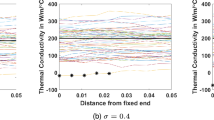Abstract
Three-dimensional finite element simulations were developed to predict the effective thermal conductivity of theoretical composite materials having complex structures. The models simulated a steady-state thermal conductivity measurement device performing measurements on theoretical materials with varying structures. The structure of a composite was considered to be composed of some simplified basic models. When the geometry, orientation type and number of dispersion are specified, the computer randomly generated the position and orientation for each dispersion and created the geometrical model and finite element mesh. The effective thermal conductivity of the theoretical composite was calculated using this method and compared to the values obtained by simple effective thermal conductivity models methods. The influence of some factors such as the volume fraction and the ratio of the thermal conductivities of the heterogeneities and the surrounding material on the effective thermal conductivity is discussed.







Similar content being viewed by others
Abbreviations
- A :
-
cross-section area of the cube
- e :
-
percentage error
- k e :
-
effective thermal conductivity
- k i :
-
thermal conductivity of the phase
- L :
-
length of the cube side
- q:
-
heat flux
- \({\mathop {Q_{1} }\limits^ \cdot }\) :
-
overall heat flux into the unit cell
- T :
-
temperature
- x, y, z :
-
spatial Cartesian coordinates
- ϕ, θ :
-
spatial spherical coordinates
- ν I :
-
relative volume of the phase i
- 1 :
-
continuous phase
- 2 :
-
dispersed phase
References
Baltz, B., & Ingber, M. (1997). A parallel implementation of the boundary element method for heat conduction analysis in heterogeneous media. Engineering Analysis with Boundary Elements, 19, 3–11.
Carson, J. K. (2006). Review of effective thermal conductivity models for foods. International Journal of Refrigeration, 29, 958–967.
Carson, J. K., Lovatt, S. J., Tanner, D. J., & Cleland, A. C. (2003). An analysis of the influence of material structure on the effective thermal conductivity of theoretical porous materials using finite elements simulations. International Journal of Refrigeration, 26, 873–880.
Cheng, S. C., & Vachon, R. I. (1969). The prediction of the thermal conductivity of two and three phase solid heterogeneous mixtures. International Journal of Heat and Mass Transfer, 12, 249–264.
Davies, L. J., & Fryer, P. J. (2000). Effective electrical conductivity of foods. Proceedings of the 8th International Congress on Engineering and Food, 9–12 April 2000, Puebla City, Mexico (pp. 146–150). Lancaster, PA, USA: Technomic Publishing Co.
Davis, T. H., Valencourt, L. R., & Johnson, C. E. (1975). Transport processes in composite media. Journal of the American Ceramic Society, 58, 447–452.
Eucken, A. (1940). Allgemeine Gesetzmassigkeiten fur das Warmeleitvermogen verschiedener Stoffarten und Aggregatzustande. Forschung Gabiete Ingenieur, 11, 6–20.
Farouki, R. T. (1986). The characterization of parametric surface sections. Computer Vision, Graphics, and Image Processing, 33, 209–236.
Kirkpatrick, A. (1973). Percolation and conduction. Reviews of Modern Physics, 45, 574–588.
Kopelman, I. J. (1966). Transient heat transfer and thermal properties in food systems, PhD thesis. East Lansing, USA: Michigan State University.
Krach, A., & Advani, S. G. (1996). Influence of void shape, void volume and matrix anisotropy on the effective thermal conductivity of a three-phase composite. Journal of Composite Materials, 30, 933–946.
Landauer, R. (1952). The electrical resistance of binary metallic mixtures. Journal of Applied Physics, 23, 779–784.
Levy, F. L. (1981). A modified Maxwell–Eucken equation for calculating the thermal conductivity of two-component solutions or mixtures. International Journal of Refrigeration, 4, 223–225.
Murakami, E. G., & Okos, M. R. (1989). Measurement and prediction of thermal properties of foods. In Food properties and computer-aided engineering of food processing systems (pp. 3–48). Dordrecht, Germany: Kluwer.
Pham, Q. T. (1989). Prediction of thermal conductivity of meats and other animal products from composition data. In W. E. L. Spiess & H. Schubert (Eds.), Engineering and food, vol. 1, 1990 (pp. 408–423). London: Elsevier Applied Science.
Pham, Q. T., & Willix, J. (1989). Thermal conductivity of fresh lamb meat, offals and fat in the range −40 to +30°C: Measurements and correlations. Journal of Food Science, 54, 508–515.
Pham, Q. T., Sutjiadi, M. R., Sagara, Y., & Do, G. S. (2006). Determination of thermal conductivity of frozen meat by finite element modelling, Proceedings of FOODSIM Conference, 15-17 June 2006, Naples, Italie, pp. 175–178. Eurosis, Ostend, Belgium.
Progelhof, R. C., Throne, J. L., & Reutsch, R. R. (1976). Methods for predicting the thermal conductivity of composite systems: A review. Polymer Engineering Science, 16, 615–625.
Quintard, M., & Whitaker, S. (1995). Local thermal equilibrium for transient heat conduction: Theory and comparison with numerical experiments. International Journal of Heat and Mass Transfer, 38, 2779–2796.
Saad, Y., & Schultz, M. H. (1986). GMRES: A generalized minimal residual algorithm for solving nonsymmetric linear systems. SIAM Journal of Science and Statistical Computing, 7, 856–869.
Tarnawski, V. R., Cleland, D. J., Corasaniti, S., Gori, F., & Mascheroni, R. H. (2005). Extension of soil thermal conductivity models to frozen meats with low and high fat content. International Journal of Refrigeration, 28, 840–850.
Wang, J. F., Carson, J. K., North, M. F., & Cleland, D. J. (2006b). A new approach to modelling the effective thermal conductivity of heterogeneous materials. International Journal of Heat and Mass Transfer, 49(17,18), 3075–3083.
Yibin, X., & Koichi, Y. (2004). Automatic FEM model generation for evaluating thermal conductivity of composite with random materials arrangement. Computational Materials Science, 30, 242–250.
Author information
Authors and Affiliations
Corresponding author
Rights and permissions
About this article
Cite this article
Floury, J., Carson, J. & Pham, Q.T. Modelling Thermal Conductivity in Heterogeneous Media with the Finite Element Method. Food Bioprocess Technol 1, 161–170 (2008). https://doi.org/10.1007/s11947-007-0001-6
Received:
Accepted:
Published:
Issue Date:
DOI: https://doi.org/10.1007/s11947-007-0001-6




